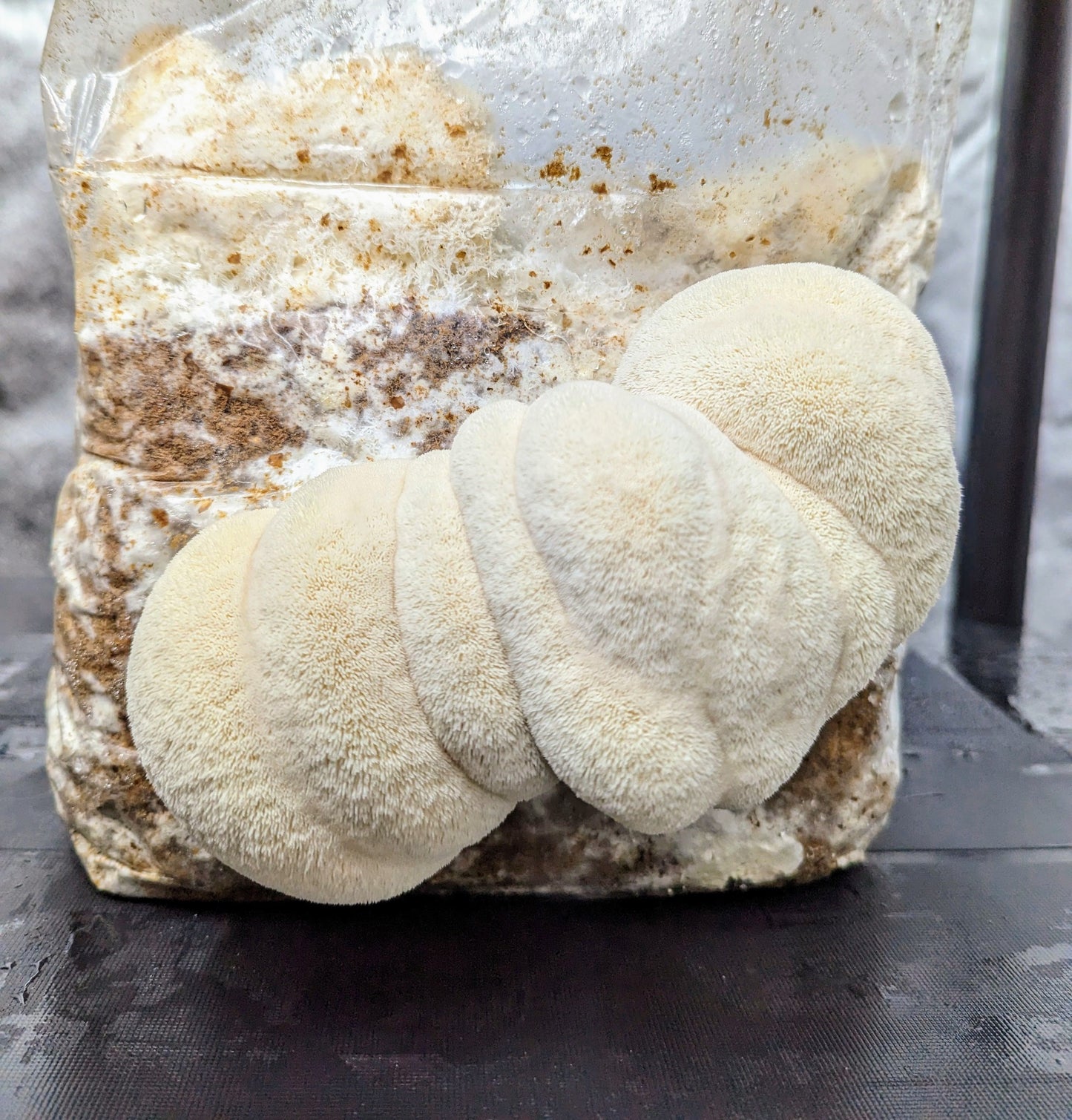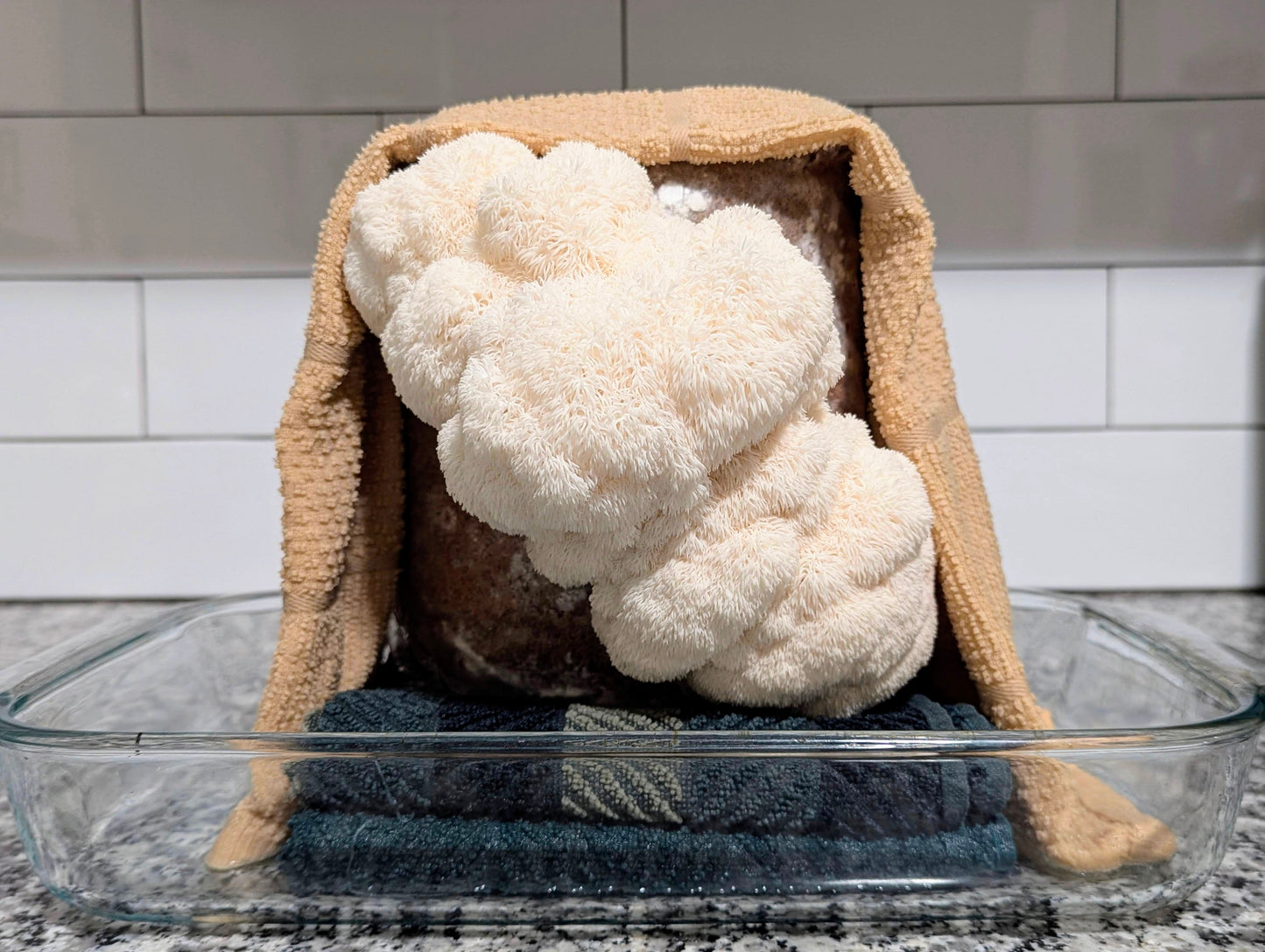Prime Fungi
Lion's Mane Mushroom Grow Kit
Lion's Mane Mushroom Grow Kit
Couldn't load pickup availability
Grow your own fresh Lion’s Mane mushrooms at home with this premium 5-pound mushroom grow kit. Perfect for beginners, foodies, gardeners, and mushroom lovers, this all-in-one kit produces delicious, brain-boosting, nootropic mushrooms right from your kitchen counter. No grow tent, special equipment, or experience required. Just open the box, follow the simple instructions, mist with the included spray bottle, and enjoy multiple flushes of gourmet Lion’s Mane mushrooms in no time at all.
Lion’s Mane, also known as Hericium erinaceus, is prized for its rich umami flavor, meaty texture, and powerful health benefits, including cognitive support and immune enhancement. This kit is a great gift for chefs, wellness enthusiasts, and anyone interested in growing mushrooms at home. Handmade in the USA using all-natural ingredients by our family-owned small business, each kit is crafted for maximum freshness, high yield, and a hassle-free growing experience.
Buy Lion’s Mane mushroom grow kit, Hericium erinaceus kit, mushroom growing kit for beginners, 5 pound mushroom block, grow mushrooms at home, fresh mushroom kit, brain boosting mushrooms, nootropic mushrooms, culinary mushrooms, medicinal mushrooms, kitchen counter mushroom kit, gourmet mushroom growing, organic mushroom kit, all natural mushroom grow kit, DIY mushroom kit, mushroom gift box, handmade in USA mushroom kit, indoor mushroom farm, edible mushroom kit, spray and grow mushroom kit.
Detailed Lion's Mane Mushroom Growing Instructions:
Start by selecting a clean spot in your kitchen with indirect natural light and a stable temperature between 60 and 70 degrees Fahrenheit. Unbox your Lion’s Mane mushroom grow kit and locate the marked fruiting area on the bag. When you’re ready to begin, use a clean knife to make a horizontal slice two inches long directly where it’s marked. This slice creates an opening for the mushrooms to grow from.
Place a small clean towel, folded, in the bottom of your casserole dish. Pour a small amount of clean water into the dish so the towel becomes damp but not submerged. Set the grow kit upright in the dish, directly on top of the damp towel, with the sliced area facing out or slightly upward to allow for airflow and mushroom formation. There’s no need to open the top of the bag or disturb the contents inside.
Use a clean spray bottle filled with water to mist around the sliced area two to three times a day. Spray the air surrounding the slice and the inner sides of the casserole dish to maintain humidity, but do not spray the mushroom itself or the exposed substrate directly. Moisture sitting on the mushroom or substrate surface can lead to rot or contamination. The goal is to raise ambient humidity, not soak the kit.
To help trap humidity, drape a clean, damp towel loosely over the entire setup like a tent. Keep the towel slightly elevated so it doesn’t rest against the sliced area. You can re-wet the towel once a day by misting it or briefly soaking and wringing it out so it stays lightly damp. The towel will act as a simple humidity dome.
You’ll begin to see tiny primordia, or pins, forming at the slice once the conditions are right. Mushrooms can be unpredictable, some will pin in about a week while others may take longer. Keep misting the air around the block and make sure the towel stays damp, but avoid spraying directly on the developing mushrooms. As long as the environment remains humid and well ventilated, they’ll continue to grow and mature naturally.
Harvest the Lion’s Mane when it’s about the size of a baseball and the spines are long but still white and fresh. Use a clean knife to cut the mushroom off at the base, as close to the grow block as possible. After harvesting, tape over the opening where the mushrooms grew from and make a new slice at another location on the bag and repeat the process.
Once the block stops producing, you can compost it or bury it under wood chips outside to potentially yield mushrooms in the future.
Now for troubleshooting.
If no mushrooms appear after two weeks, the most common cause is low humidity or poor airflow. Try increasing how often you mist the air around the kit and briefly lift the towel for few minutes each day to refresh the air. Make sure the kit is not kept in a very dry, cold, or hot location.
If pins form and then dry out or stop growing, humidity is too low. Mist more frequently and keep the towel slightly wetter. You can also loosely tent the entire dish with a large clear container or bag with holes to trap more humidity.
If the mushrooms look yellow it is a lack of humidity. If they grow very slowly, or develop a fuzzy texture, there may not be enough air circulation and too much humidity.
If you see green, black, or pink mold, that’s a sign of contamination. This may be due to direct spraying or poor air exchange. Do not spray the mushroom or substrate surface. Remove any small contaminated areas with a clean knife. If the contamination spreads, dispose of the block.
If your kitchen air is especially dry, you can place the whole dish setup inside a larger clear bin or tote, with the lid propped open slightly for air. This will help trap moisture without suffocating the kit.
Share




